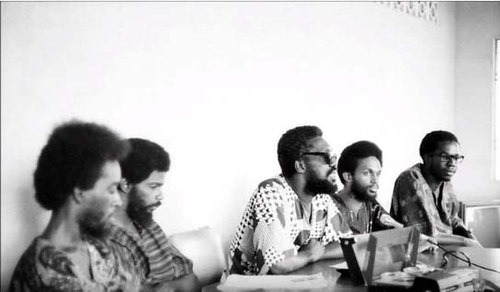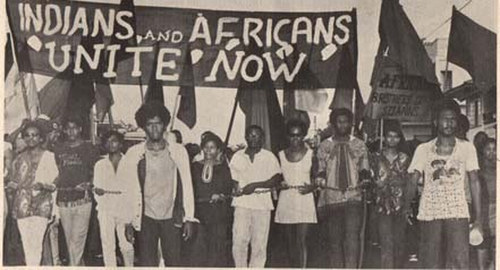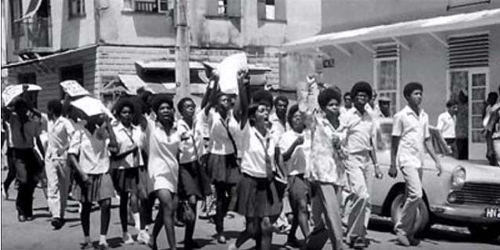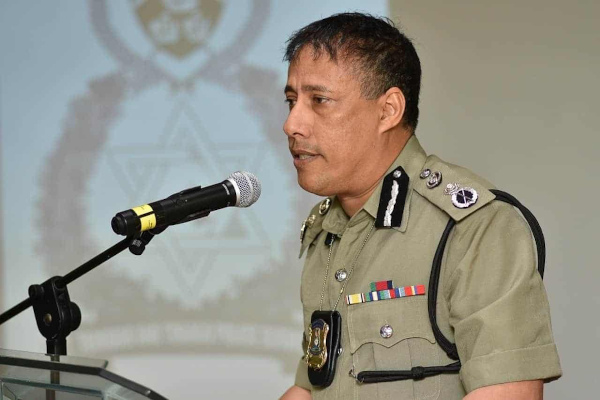The following Letter to the Editor was submitted by ex-PP Minister and NJAC member Embau Moheni on the death of Basil Davis and the subsequent outpouring of emotion in 1970, which led to one of Trinidad and Tobago’s largest funeral processions:
On 26 February 1969, the Chief Servant Makandal Daaga—then Geddes Granger—formed the National Joint Action Committee (NJAC).
This was in direct response to the arrest of a number of Caribbean students at the Sir George Williams University in Canada, and the subsequent visit of the Canadian Governor General, Roland Michener, to Trinidad and Tobago and the University of the West Indies (UWI).

(Courtesy Embau Moheni/NJAC)
The arrest of Caribbean students, including some from Trinidad and Tobago, arose out of protest actions they had taken against the racist treatment received from one of the professors at the Sir George Williams University.
Makandal Daaga, along with other students at UWI, took strong objection to welcoming a Canadian Governor General to UWI at the same time our students were receiving unfair and racist treatment in Canada.
The students therefore took protest action and debarred Governor Michener from entering the university.
Continuing negative developments with regard to the students arrested in Canada who needed as much support as possible from the people of the Caribbean, as well as growing concern over the deteriorating conditions of life in Trinidad and Tobago led to the formation of the National Joint Action Committee by the Chief Servant Makandal Daaga, which incorporated a number of groupings.
NJAC was able to prevent the planned retaliatory cancellation of scholarships of students who had been involved in protest action against Canadian Governor General Michener in defence of our students in Canada.

(Courtesy Queensu.ca)
Most crucially, NJAC with the support of the population, was able to gain the release of the Caribbean students who had been studying at the Sir George Williams University. The release of the students was a major victory for NJAC and the people of the Caribbean.
Beyond this was the fact that NJAC was heavily involved in community activities across the country. Much of this activity was centred on workers’ rights and included protest action. The bus strike of April 1969 was one of the issues in which NJAC got seriously involved.
On the 26th of February 1970, an international day of solidarity with the Sir George Williams’ students was called, and NJAC led a demonstration through Port of Spain with stops being made at the Canadian Embassy as well as the Royal Bank of Canada.
Before the march was over they took their protest into the Roman Catholic Cathedral, an act that led to the arrest of a number of the leaders and their being charged with desecrating a place of worship. Even though Archbishop Pantin certified that there had been no desecration of the Cathedral, Makandal Daaga and other NJAC leaders were still put on trial.
What followed was fifty-six days of continuous demonstrations and the biggest mass movement in the history of Trinidad and Tobago.

(Courtesy Embau Moheni/NJAC)
Woodford Square became a major centre of this movement and was re-named the People’s Parliament. It was here, outside the gates at Woodford Square that a young demonstrator, Basil Davis, was shot dead by a police officer, Joshua Gordon, on Monday 6 April 1970.
For NJAC, Basil Davis had an equally spiritual relevance. He represented the type of person who joined the revolution in 1970.
He was an ordinary brother from the blocks of Barataria. His late mother testified that Basil was a very kind person who shared what little he had with his other brothers and sisters. The message of 1970 inspired him to join the movement for change and he died as he lived, expressing compassion.
It was reported that a policeman was arresting someone who appeared to be either a vagrant or to be mentally challenged. Basil Davis begged the officer to give the man a chance. He instead was gunned down in cold blood when he protested the officer’s decision to arrest him also.
The response of the population was one of total indignation.

(Courtesy Embau Moheni/NJAC)
The funeral for Basil Davis on the 9 April 1970, was transformed into the largest, most dynamic demonstration in the history of Trinidad and Tobago. Over one hundred thousand persons took part in the funeral march from Port of Spain to San Juan.
NJAC had requested that no one wear the traditional black for the funeral. People were asked to wear red and so they did.
NJAC wanted to express its anger at the murder of Basil Davis, and to indicate its greatest determination to continue its thrust for fundamental change in the country.
Basil Davis was given a state funeral by the population. His body lay in state in the bandstand at Woodford Square, the starting point of most of the demonstrations. After the funeral service and speeches, the march began to proceed to the San Juan cemetery.
The discipline of the demonstrators was so exceptional that the procession took place in virtual silence, except for the shuffling of the feet, the beating of the drums and the occasional announcements from the car mikes. Many will recall that when the front of the demonstration reached the Port of Spain flyover, the tail of it had had not even left Woodford Square.

(Courtesy Embau Moheni/NJAC)
In addition to the massive size of the funeral, there are many points of interest to consider. It must be noted that Basil Davis was killed at a time when more and more sectors of the society were joining the movement. There was indeed a groundswell of support for NJAC’s demands sweeping across the country.
Five days before the funeral, the OWTU declared its support for NJAC and the movement. The day before the funeral, the OWTU workers at T&TEC had their own march in support of the movement.
Organised labour, through the OWTU, had taken its position. The movement could no longer be labelled as merely a group of university student radicals in alliance with the unemployed urban youth.
Of much significance also, was the resignation of the Deputy Prime Minister, ANR Robinson, from the Cabinet and the PNM on the 14 April 1970, five days after the funeral. He was a founding member of the PNM and considered a likely successor to then prime minister Dr Eric Williams. This was an extremely serious development.
Basil Davis was recognised as the first martyr of the Trinidad and Tobago Revolution of 1970.

(Courtesy Embau Moheni/NJAC)
He gave his life in the course of his humble pursuit of a New and Just Society in Trinidad and Tobago. As we look back 46 years and reflect on the contributions of the Trinidad and Tobago Revolution of 1970 the memories of Basil Davis—a young man of only 24 years of age—lives on in the hearts and minds of all those who love right and yearn for justice.
Embau Moheni is the Deputy Political Leader of the National Joint Action Committee (NJAC) and Chairman of the National Action Cultural Committee (NACC). He is a former Minister in the Ministry of National Security under the People’s Partnership Government. He was twice arrested as a teenager during the uprising of the early 1970s.
 Wired868 Wired868 for smart sport news and opinion
Wired868 Wired868 for smart sport news and opinion







Was the biggest funeral I ever saw in trinidad from town to sanjuan people for so
Obstructing an Officer in the execution of his duties + assaulting a Police Officer + Resisting arrest = Martyr?
Good history lesson though, never knew. Sad that the young man was killed. I wonder what came of his siblings, if they were successful in life? Would be nice to know.
I have heard several stories from persons who have generally been apolitical over the years, that this funeral sent shockwaves through the hierachy of the PNM and critically bothered the then PM. I cannot recall the name of the police officer involved in information gathering at the time, however I was told that when he reported to Dr. Williams about the size of the funeral and about the crowded Eastern Main Road between San Juan and Port of Spain, “The Doc” literally panicked. No wonder a State of Emergency was declared 2 weeks later.
46 years later that movement/revolution is being undone by the young criminal elements.
I was a student at UWI at the time, joined the black power movement , and Basil Davis funeral is an event that has remained in my memory. The funeral demonstrated the widespread support of the movement.
Was his murderer ever brought to justice?
Embau Amenemhat Moheni, can you answer this?
Rest In Power Basil Davis!
Thank you Lasana Liburd.
The article does not go into sufficient depth about what post Independent Trinidad was like. The predominance of a colonial workforce that were still holding the best jobs 8 years after Independence and a white is right mentality that suppressed the black voice and status to one of poverty despite blacks having sought an education and excelled in academics. This caused a large measure of disillusionment amongst the black youth.
It was meant to be a snapshot of a brief period in a momentous year. One cannot tell our post independence history in 1,200 words.
Speaking of snapshot, is there no photo of the late Basil Davis?
I learnt something today of my counties history….Thank you Wired868 for sharing this.
Love a lil history class! ??
All to be said now is…, I was there and I remembered those times and experiences and I am a better more fair person for them…nothing comes good without a sacrifice. Thank you Basil and compassionate you were, just as your mother declared. Thank you Makandal for your sensitivities and compassion too and for treating me with human dignity and much respect.